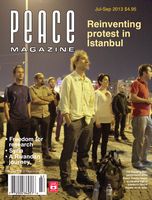
Peace Magazine Jul-Sep 2013, page 2. Some rights reserved.
Search for other articles by peacemag here
Many people who even remember talk about nuclear winter from last century think it was somehow discredited. Not so. The climate scientist Alan Robock and his associates have continued to study it and nobody has cast doubt on their climate models. Robert Kozel of the Nuclear Age Peace Foundation interviewed the 63-year-old Rutgers scientist. Even after the New START agreement is fulfilled in 2017, there will still be enough nuclear weapons in American and Russian arsenals to produce a full nuclear winter with temperatures below freezing in the summer.
Robock points out that the military planners still operate on the MAD assumption—that the dangers of mutual retaliation are the reason they don’t use nuclear weapons. The real fact is that it would be suicide to do so. “If you attacked a country and produced all these fires and smoke, it would come back to haunt you. It would affect your agricultural production.”
How about nuclear war between some new nuclear powers, such as India and Pakistan? Suppose each of them used only 50 Hiroshima-size nuclear weapons. That’s the simplest size to build, and it would be less than one percent of the global nuclear arsenal, and less than half of each of their arsenals. Yet twenty million people would die, and about five million tons of smoke would go up into the atmosphere, last more than a decade, and cause cooling of the earth’s surface. It would be the coldest temperatures ever experienced in recorded history—colder than the “Little Ice Age” a couple of hundred years ago in which there was famine around the world. This would devastate the world food market. Robock and his colleagues estimate that up to a billion people might die.
Yet military planners ignore the research. A Pakistani colleague told Roback that his people are really proud of their accomplishment and, “If you started doing research into this in Pakistan to show that they can’t be used because of environmental dangers, you would be a pariah. People would criticize you as being unpatriotic.”
Source: Nuclear Age Peace Foundation.
Japan is preparing to start up a huge nuclear-fuel reprocessing plant in its northern Aomori prefecture. It will be able to produce nine tons of weapon-usable plutonium per year—enough to build 2,000 bombs. However, the plutonium is supposed to be used solely for power generation. Prime Minister Shiinzo Abe’s ruling Liberal Democratic Party favors nuclear power and intends to push forward with the Rokkasho Plant. Its startup has been delayed 19 times because of technical problems, and it was mothballed after more than $21 billion had been invested in it since 1992.
The Obama administration objects to the plan to finish and open the plant, saying that it will force China to respond to prove that Beijing, not Tokyo, is the most dominant nuclear player in the region. Moreover, hawkish South Korean and Japanese politicians are now considering openly whether their governments should pursue nuclear weapons, especially since North Korea tested another bomb in February. South Korea tells the US that it should have the same capabilities as Japan. China has a new agreement with a French nuclear power company to construct a reprocessing nuclear fuel plant for civilian purposes, which will be on the same scale as Rokkasho.
Source: The Wall Street Journal, May 1, 2013.
| Country | 2012 Spending | Percent of GDP | |||
| (Including war & nuclear) | 645.7 | 4.12 | |||
| Canada | 18.4 | 1.04 | |||
| China | 102.4 | 1.24 | |||
| Russia | 59.9 | 3.06 | |||
| United Kingdom | 64.1 | 2.63 | |||
| France | 48.1 | 1.86 | |||
| Germany | 40.4 | 1.20 | |||
| Japan | 59.4 | 0.99 | |||
| India | 38.5 | 1.98 | |||
| Italy | 23.6 | 1.19 | |||
| Brazil | 35.3 | 1.45 | |||
| Australia | 25.1 | 1.63 | |||
| Saudi Arabia | 52.5 | 7.99 | |||
| South Korea | 29.0 | 2.52 | |||
| Israel | 19.4 | 7.85 | |||
| Taiwan | 10.3 | 2.21 | |||
| Iran | 23.9 | 4.95 | |||
| North Korea | ? | ? | |||
| Pakistan | 5.9 | 2.55 | |||
| Venezuela | 6.1 | 1.80 | |||
| Iraq | 14.7 | 11.28 | |||
| Afghanistan | 2.1 | 10.54 | |||
| Oman | 6.7 | 8.42 |
Jordan | 1.8 | 5.60 |
Source: Laicie Heeley, lheeley@armscontrolcenter.org
There is no agreed-upon international definition for defence expenditure. Defence estimates for Russia and China (which regularly underreport their annual military budgets) have been reported using a method known as Purchasing Power Parity. These figures for Russia and China are significantly higher than both officially reported and market exchange rate figures.

Peace Magazine Jul-Sep 2013, page 2. Some rights reserved.
Search for other articles by peacemag here